Introduction
The Living Ministry Research Project is an important initiative taken by the Church of England, demonstrating the Church’s belief that research may be of practical benefit for ‘those in dioceses, theological education institutions, and the national Church’. The objectives include understanding ‘the factors that enable ordained clergy to flourish’ and understanding ‘how these factors vary according to person, background, training pathway, type of ministry, context, etc.’ (see Graveling, Reference Graveling2023, p. ii). These objectives are addressed by two methods: a ten-year, mixed-methods, longitudinal panel study, launched in 2017; and focused qualitative studies reporting on specific topics or perspectives. Two recent reports from the Living Ministry Research Project focused on the experience of clergy during the pandemic, a quantitative study reported by McFerran and Graveling (Reference McFerran and Graveling2022), and a qualitative study reported by Graveling (Reference Graveling2023). Both studies pay attention to well-being and to engagement with digital technology during the pandemic, although neither was able to establish the connection between the two.
A somewhat different approach to assessing the impact of the pandemic on the well-being of Anglican clergy was taken by two pandemic surveys run in collaboration with the Church Times: the Coronavirus, Church and You Survey, live between 8 May and 23 July 2020 (see Francis and Village, Reference Francis and Village2021a, Reference Francis and Village2021b, Reference Francis and Village2021c, Reference Francis and Village2022a; Francis, Village and Lawson, Reference Francis, Village and Lawson2020; Francis, Village, and Lewis, Reference Francis, Village and Lewis2021; Village and Francis, Reference Village and Francis2020, Reference Village and Francis2021a, Reference Francis and Village2021b, 2021c); and the Covid-19 and Church-21 Survey, live between 22 January and 23 July 2021 (see Francis, Village and Lawson, Reference Francis, Village and Lawson2021; Village, Reference Village2022; Village and Francis, Reference Village and Francis2022a, Reference Village and Francis2022b, Reference Village and Francis2022c, Reference Village and Francis2022d, Reference Village and Francis2022e, Reference Village and Francis2023a, Reference Village and Francis2023b). The distinctive characteristic of these two pandemic surveys is that they were rooted within the individual differences approach as shaped both by psychology and by theology.
Individual Differences Approach
The psychology of individual differences (see, for example, Chamorro-Premuzic, Reference Chamorro-Premuzic2007) is concerned with conceptualizing and measuring psychologically shaped patterns that characterize and shape human behaviour in consistent and predictable ways. The psychology of individual differences gives substance to constructs like personality, well-being, and attitudes. The theology of individual differences (see, for example, Francis and Village, Reference Francis and Village2015) is concerned with testing assumptions made within the psychology of individual differences against the background of theological anthropology. The theology of individual differences gives substance to differentiation between constructs such as personality and character in light of Christian insights framed by the doctrines of creation, fall and redemption. Building on a reading of Gen. 1.24, the theology of individual differences posits that fundamental differences in personality, such as differences in sex and ethnicity, may be rooted in the doctrine of creation, while differences in character may be assessed in light of the doctrines of fall and redemption. Such differentiation encourages the psychology of individual differences to think clearly about the conceptualization and assessment of personality and character as distinct constructs, and encourages the Church to prioritize the Christ-like transformation of character, while respecting individual differences in personality. The individual differences approach was reflected in the design of the two Church Times surveys in four key ways.
First, the Church Times pandemic surveys conceptualized and operationalized clergy personal and professional psychological well-being in light of the balanced affect approach rooted in the work of Bradburn (Reference Bradburn1969) and introduced to clergy studies by the Francis Burnout Inventory (FBI; Francis, Kaldor, Robbins and Castle, Reference Francis, Kaldor, Robbins and Castle2005). The FBI operationalized negative affect by the Scale of Emotional Exhaustion in Ministry (SEEM) and positive affect by the Scale of Satisfaction in Ministry (SIMS). The theory underpinning this model is that negative affect and positive affect are not opposite ends of a single continuum but operate as separate (but correlated) systems. According to this theory, the detrimental consequences of high levels of negative affect can be mitigated by high levels of positive affect. The practical insight from this theory is that, although it may be difficult to remove from clergy experience the factors that generate negative affect, good pastoral oversight can facilitate the development of factors that support positive affect. The validity of this theory has now been established in a series of studies among 744 clergy serving in the Presbyterian Church USA (Francis, Village, Robbins and Wulff, Reference Francis, Village, Robbins and Wulff2011), 155 Catholic priests serving in Italy (Francis, Laycock and Crea, Reference Francis, Laycock and Crea2017), 95 Catholic priests and 61 Catholic religious sisters serving in Italy (Francis, Crea and Laycock, Reference Francis, Crea and Laycock2017), 358 Anglican clergy serving in Wales (Village, Payne and Francis, Reference Village, Payne and Francis2018), 90 Anglican clergy serving in England (Francis, Laycock and Ratter, Reference Francis, Laycock and Ratter2019), 287 Catholic priests serving in Italy (Francis Crea, and Laycock, Reference Francis, Crea and Laycock2021), and 803 Methodist ministers serving in Great Britain (Francis, Village and Haley, Reference Francis, Village and Haley2023).
The Church Times pandemic surveys conceptualized and operationalized change in clergy personal psychological well-being by a new measure, grounded in the same theory. This measure, known as The Index of Balanced Affect Change (TIBACh; Francis and Village, Reference Francis and Village2021b), was designed to capture perceived changes in both positive affect and negative affect as a consequence of experiencing the pandemic. Tested among a sample of 4449 individuals affiliated with the Church of England of whom 29 per cent were clergy and 71 per cent were lay, the two five-item measures showed acceptable internal consistency reliability, with Cronbach’s alphas of .70 for positive affect and .83 for negative affect. Construct validity was tested against an independent measure of coping during lockdown. Coping was positively correlated with positive affect and negatively correlated with negative affect. Crucially, for the balanced affect model, there was a significant interaction effect of positive and negative affect on coping, showing that the ameliorating effect of positive affect on coping increased with increasing levels of negative affect.
Second, the Church Times pandemic surveys included a recognized measure of personality in order to expand the contextual location of clergy within psychological as well as sociological terms. The model of personality employed was psychological type theory as grounded in the work of Jung (Reference Jung1971) and operationalized by the Francis Psychological Type and Emotional Temperament Scales (FPTETS; Village and Francis, Reference Village and Francis2023c). Psychological type theory was selected, rather than the Big Five Factor Model of personality (Costa and McCrae, Reference Costa and McCrae1985), the Three Major Dimensions of Personality (Eysenck and Eysenck, Reference Eysenck and Eysenck1991), or the 16 Personality Factors (Cattell, Eber and Tatsuoka, Reference Cattell, Eber and Tatsuoka1970) in light of its better fit with a theology of individual differences that distinguishes between personality and character. In particular, the work of Lloyd (Reference Lloyd2008, Reference Lloyd2012, Reference Lloyd2015, Reference Lloyd2022) has critiqued the implicit value assumptions within the Big Five Factor Model of personality that confuse personality and character. The psychometric properties of the Francis Psychological Type Scales (FPTS) have been well supported in studies among clergy (see Francis, Laycock and Brewster, Reference Francis, Laycock and Brewster2017; Francis and Village, Reference Francis and Village2022b; Payne, Lewis and Francis, Reference Payne, Lewis and Francis2021; Village, Reference Village2021). The psychometric properties of the more recent FPTETS have been documented by Village and Francis (Reference Village and Francis2022f, Reference Village and Francis2023c).
Third, the Church Times pandemic surveys included recognized measures of ecclesiological and theological constructs designed to differentiate the complex streams of tradition among Anglican clergy. In terms of church tradition, Randall (Reference Randall2005) consolidated earlier work reported by Francis and Lankshear (Reference Francis and Lankshear1995a, Reference Francis and Lankshear1995b, Reference Francis and Lankshear1996), and by Francis, Lankshear and Jones (Reference Francis, Lankshear and Jones1998, Reference Francis, Lankshear and Jones2000) in order to test and to establish two semantic differential grids: one to map the differences between Anglo-Catholic, Broad Church and Evangelical positions within the Church of England, and the second to assess the influence of the Charismatic movement. The validity and utility of these measures were further tested by the two earlier Church Times surveys conducted in 2001 and 2013 as reported by Francis, Robbins and Astley (Reference Francis, Robbins and Astley2005) and Village (Reference Village2018a).
In terms of theological stance, research conducted among Church of England clergy has long recognized that the broad category of liberal versus conservative provides a key measure to which a number of beliefs and attitude are linked. Alongside their measures of church tradition, Francis, Lankshear and Jones (Reference Francis, Lankshear and Jones1998, Reference Francis, Lankshear and Jones2000) and Randall (Reference Randall2005) employed a third semantic differential grid where the poles were defined by the two anchors ‘liberal’ and ‘conservative’. More recently a detailed investigation among 9339 lay and ordained members of the Church of England suggested that there are three main components to this general stance: preference for modern versus traditional worship, liberal versus conservative doctrinal belief and liberal versus conservative views on morality (Village, Reference Village2018b). The Church Times pandemic surveys used three separate scales, rather than the single generic scale, because the pandemic may have raised issues about worship and doctrine, and these may not necessarily predict the same sets of beliefs or attitudes.
Fourth, the Church Times pandemic surveys included a range of attitudinal measures to augment investigation into behaviours, beliefs and opinions. The attitudinal dimension is of particular interest and importance within the individual differences tradition where attitudes are conceptualized as deep-seated and relatively stable affective responses that help to predict more surface behaviour and opinions. For example, in their study ‘Shaping Attitudes toward Church in a Time of Coronavirus’, Village and Francis (Reference Village and Francis2021a) developed and tested three scales designed to measure attitudes toward three key areas of experience affected by the pandemic: the Pro Church Buildings Scale, the Anti Church Lockup Scale and the Pro Virtual Church Scale. Each scale showed acceptable levels of internal consistency reliability in terms of the Cronbach alpha coefficient (Cronbach, Reference Cronbach1951).
Having developed and tested these three scales, Village and Francis (Reference Village and Francis2021a) examined the power of five sets of predictor variables to account for individual differences within these attitudinal domains. These sets of predictor variables drew on the range of measures intentionally embedded within the Church Times pandemic surveys, and were entered into hierarchical multiple regression models in the following fixed order: personal factors (sex and age), psychological factors (psychological type scores), social location (ordination status, education and geographic location), theological stance (modern versus traditional worship, liberal versus conservative views on doctrine and liberal versus conservative views on morality), and church tradition (Anglo-Catholic, Broad Church, Evangelical and Charismaticism). The three scales (Pro Church Buildings Scale, Anti Church Lockup Scale and Pro Virtual Church Scale) were predicted by slightly different sets of variables, but in each case personal factors and psychological factors retained some predictive power after controlling for other factors.
Research Question
Against this background, and drawing on data generated by the second of the Church Times pandemic surveys, Covid-19 and Church-21, the present analyses employed the individual differences approach to assess the broad question concerning the connection between changes in clergy personal psychological well-being during the pandemic and the move to digital/online technology. Recognizing the crucial connection between the precise formulation of the research question and the capacity to operationalize that question in light of the available data, the initial broad question was sharpened in four ways. First, ‘changes in clergy psychological well-being’ were conceptualized as assessing independently changes in positive affect and changes in negative affect as operationalized by the TIBACh. Second, ‘the move to digital/online technology’ was operationalized in two distinct ways, differentiating between behaviour and underlying attitude. Consistent with the wider perspective of the individual differences approach to prioritize the attitudinal dimension, a new measure was developed and tested to assess confidence in the digital/online future. Third, recognizing that the simple bivariate relation between confidence in the digital/online future and changes in negative affect and positive affect could be contaminated by a range of extraneous variables, a full set of control variables were brought into play. Fourth, recognizing that these control variables may have an impact on confidence in the digital/online future, the analyses were conducted in two steps. In step one, confidence in the digital/online future served as the dependent variable. In step two, positive affect and negative affect served as the dependent variable in two parallel models, with confidence in the digital/online future entered into the model as the final predictor variable. This strategy then formulated the research question as assessing whether confidence in the digital/online future contributes additional predictive power to changes in positive affect and to changes in negative affect, after the predictive power of all the control variables has been taken into account.
Method
Procedure
The Covid-19 and Church-21 survey was created on the Qualtrics XM platform. It was promoted through the Church Times, the main newspaper of the Church of England, and directly through a number of dioceses. It opened on 22 January and closed on 23 July 2021. It was completed by 2292 Anglicans living in England. For this study we examined a subsample of 544 ordained clergy under the age of 70, who had completed all the requisite parts of the survey.
Sample Profiles
This subsample of 544 ordained clergy under the age of 70 comprised 46 per cent women and 54 per cent men, the majority (78 per cent) were in their 50s or 60s, and 66 per cent were stipendiary clergy working in parishes (Table 1). In terms of church tradition, 45 per cent identified as Broad Church, 29 per cent as Anglo-Catholic and 25 per cent as Evangelical.
Table 1. Sample profile

Note: N = 544. SSM = Self-Supported Ministers.
Core Instruments
Confidence in the digital/online future was assessed by the seven-item Scale of Confidence in the Digital/Online Future (SoCiDOF) (Table 2), with each item rated on a five-point Likert scale ranging from ‘strongly agree’ (5) to ‘strongly disagree’ (1). Scores could range from 7 to 35, a high score indicating a positive attitude toward engaging with online worship and digital manifestations of church.
Table 2. Scale of Confidence in the Digital/Online Future (SoCiDOF)
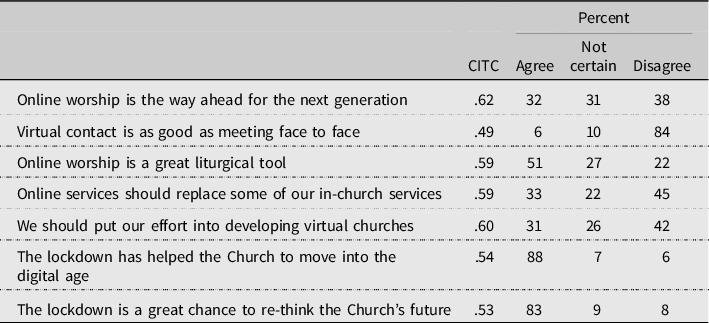
Note: N = 544. CICT = Corrected Item Total Correlation.
Experience of virtual church was assessed by two dummy variables. The survey asked clergy if they had led either pre-recorded or live-streamed online services. Responses were dummy coded so that 0 = had not led any online services and 1 = had led either or both sorts of online service. Respondents were also asked if they had used digital media for the following activities: Bible study, fellowship or prayer groups, Lent or Advent groups, work with primary-aged children, work with teenagers, ministry team meetings, Parochial Church Council meetings, pastoral care, or ‘other’. Responses for each were ‘never’, ‘tried as a one off’, ‘used sometimes’, and ‘normal practice now’. Those who responded ‘normal practice now’ to three or more of these categories were classed as regular users of digital ministry (= 1) as opposed to those who were not (= 0).
Psychological wellbeing change during the pandemic was assessed by the two components of TIBACh (Francis and Village, Reference Francis and Village2021b; Village and Francis, Reference Village and Francis2021c, Reference Village and Francis2022d). This instrument consists of two five-item scales: Positive Affect (PA), comprising happiness, excitement, thankfulness, hopefulness and confidence; and Negative Affect (NA), comprising exhaustion, anxiety, stress, fatigue and frustration. Each item was rated on a five-point Likert scale ranging from ‘much more’ (5) through ‘about the same’ (3) to ‘much less’ (1). In this sample, the scales had good internal reliability as measured by Cronbach’s alpha (PA = .78, NA = .78).
Control Variables
Personal variables included sex (male = 0, female =1), age (by decade 18–29 = 2, 30–39 = 3, 40–49 = 4, 50–59 = 5, 60–69 = 6). Contextual variables included ministry role (1 = stipendiary parochial clergy, 0 = other clergy) and location type (1 = rural, 0 = other).
Psychological variables were assessed using the revised version of the Francis Psychological Type and Emotional Temperament Scales (Village and Francis, Reference Village and Francis2022f, Reference Village and Francis2023c, Reference Village and Francisin press). This 50-item instrument comprises four sets of ten forced-choice items related to each of the four components of psychological type – orientation (extraversion or introversion), perceiving process (sensing or intuition), judging process (thinking or feeling) and attitude toward the outer world (judging or perceiving) – and ten items related to emotional temperament (calm or volatile). Scores (rather than binary preferences) were used to indicate inclinations for extraversion, sensing, thinking, judging and emotional volatility. Alpha reliabilities in this sample ranged from .77 to .87 (Table 3).
Table 3. Details of continuous scales
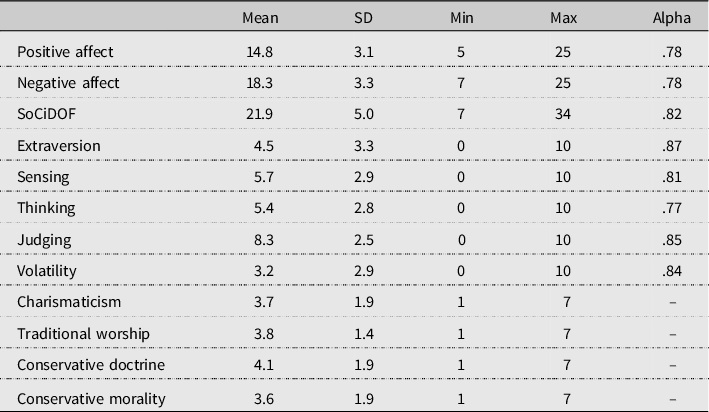
Ecclesial variables included church tradition and Charismaticism. Church tradition was assessed using a seven-point semantic differential scale labelled ‘Anglo-Catholic’ at one end and ‘Evangelical’ at the other. This scale provides a good indication of differences in belief and practice in the Church of England (Randall, Reference Randall2005; Village, Reference Village, Anthony and Ziebertz2012). In the Church of England, Anglo-Catholics tend to be liberal on moral issues and prefer traditional worship, while the reverse is true for Evangelicals (Village, Reference Village, Anthony and Ziebertz2012, Reference Village2018b). A second seven-point semantic differential scale was used to assess Charismaticism.
Theological variables were assessed on three seven-point semantic differential scales (similar to the church tradition scale) that measured theological stance in three areas: modern versus traditional worship, liberal versus conservative doctrine and liberal versus conservative stance on moral issues. These are related, but slightly different, aspects of overall liberal versus conservative expressions of faith in the Church of England (Village, Reference Village2018b).
Analysis
The first step of the analysis examined which variables were associated with confidence (or lack of it) in the digital/online future as assessed by the Scale of Confidence in the Digital/Online Future (SoCiDOF). Bivariate correlations between the SoCiDOF scores and independent variables were first examined in a correlation matrix and then hierarchical linear regression was employed to identify the independent effects of predictor variables on the SoCiDOF scores. Main effects were entered in six blocks: block one, personal variables (sex and age); block two, psychological variables (E, S, T, J and V); block three, contextual variables (ministry status and location); block four, church tradition (Anglo-Catholic, Evangelical and Charismaticism); block five, theological stance (worship, doctrine, morality); and block six, virtual church experience (led online and digital use). Interactions between church tradition and leading online worship or regular digital use were tested in two further models. Continuous variables were mean centred.
The second step of the analysis examined the relationship between the SoCiDOF scores and changes in psychological well-being during the pandemic as measured by the TIBACh. The aim was to see if the SoCiDOF scores explained significant variation in the well-being variables (positive affect and negative affect) after controlling for other factors. Predictor variables and control variables were entered in seven blocks: block one, personal variables (sex and age); block two, psychological variables (E, S, T, J and V); block three, contextual variables (ministry status and location); block four, church tradition (Anglo-Catholic, Evangelical and Charismaticism); block five, theological stance (worship, doctrine, morality); block six, virtual church experience (led online and digital use); and finally block seven, confidence in the digital future (SoCiDOF).
Results
Predicting Confidence in the Digital/Online Future
Bivariate correlations (Table 4) showed that SoCiDOF scores were significantly higher among women than men, significantly higher among Evangelicals compared with other traditions and significantly positively correlated with extraversion and Charismaticism. SoCiDOF scores were significantly lower among Anglo-Catholics, significantly lower among those living in inner cities and significantly negatively correlated with sensing, judging, traditional worship and conservative doctrine. There were a number of correlations between predictor and control variables and also among control variables, indicating the need to use multiple regression to isolate the main independent effects on individual differences in the SoCiDOF scores.
Table 4. Correlation matrix for the Scale of Confidence in the Digital/Online Future (SoCiDOF)

Note: SPC = stipendiary parish clergy; SSRM = Self-supporting and active retired ministers. N = 544. *p < .05; **p < .01; ***p < .001.
Adding the predictor and control variables in hierarchical linear regression models (Table 5) indicated that some of the bivariate correlations may have been secondary effects caused by confounding in a cross-sectional sample. The higher scores of women than men disappeared when theological stance variables were added, suggesting that the sex difference was related to women being generally more liberal than men. The only independent psychological-type effect was judging, which disappeared when church tradition was included in the model, suggesting different psychological profiles of the various traditions. The lower confidence in the digital/online future associated with preference for more traditional worship and conservative doctrine persisted after controlling for all other main effects.
Table 5. Hierarchical linear regression of the Scale of Confidence in the Digital/Online Future
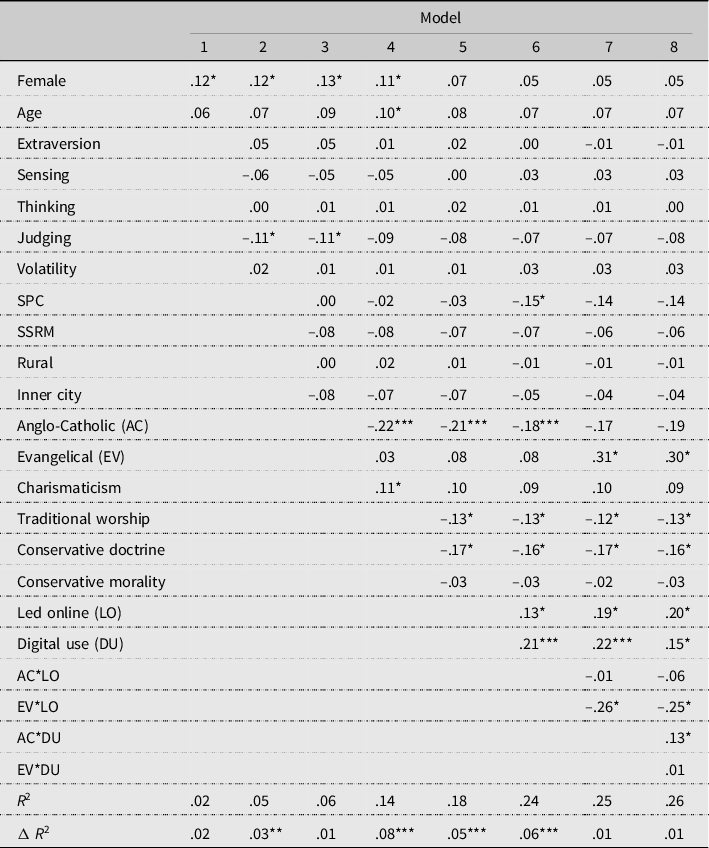
Note: For explanation, see Table 4.
Experience of leading online worship and regular use of digital environments in ministry both independently predicted higher SoCiDOF scores (Table 5, model 6). Adding interaction effects with church tradition revealed significantly different effects of leading online worship and regular digital use in ministry between some traditions. Among those who had not led online worship, Evangelicals had the highest average SoCiDOF scores and Anglo-Catholics the lowest (Figure 1). Experience of leading online services was associated with increased SoCiDOF scores among Anglo-Catholic and Broad-Church traditions, but there was no difference among Evangelicals. For digital ministry, it was the Anglo-Catholics who showed the most positive effect of regular use on SoCiDOF scores; the other two traditions showed more modest positive effects (Figure 2).
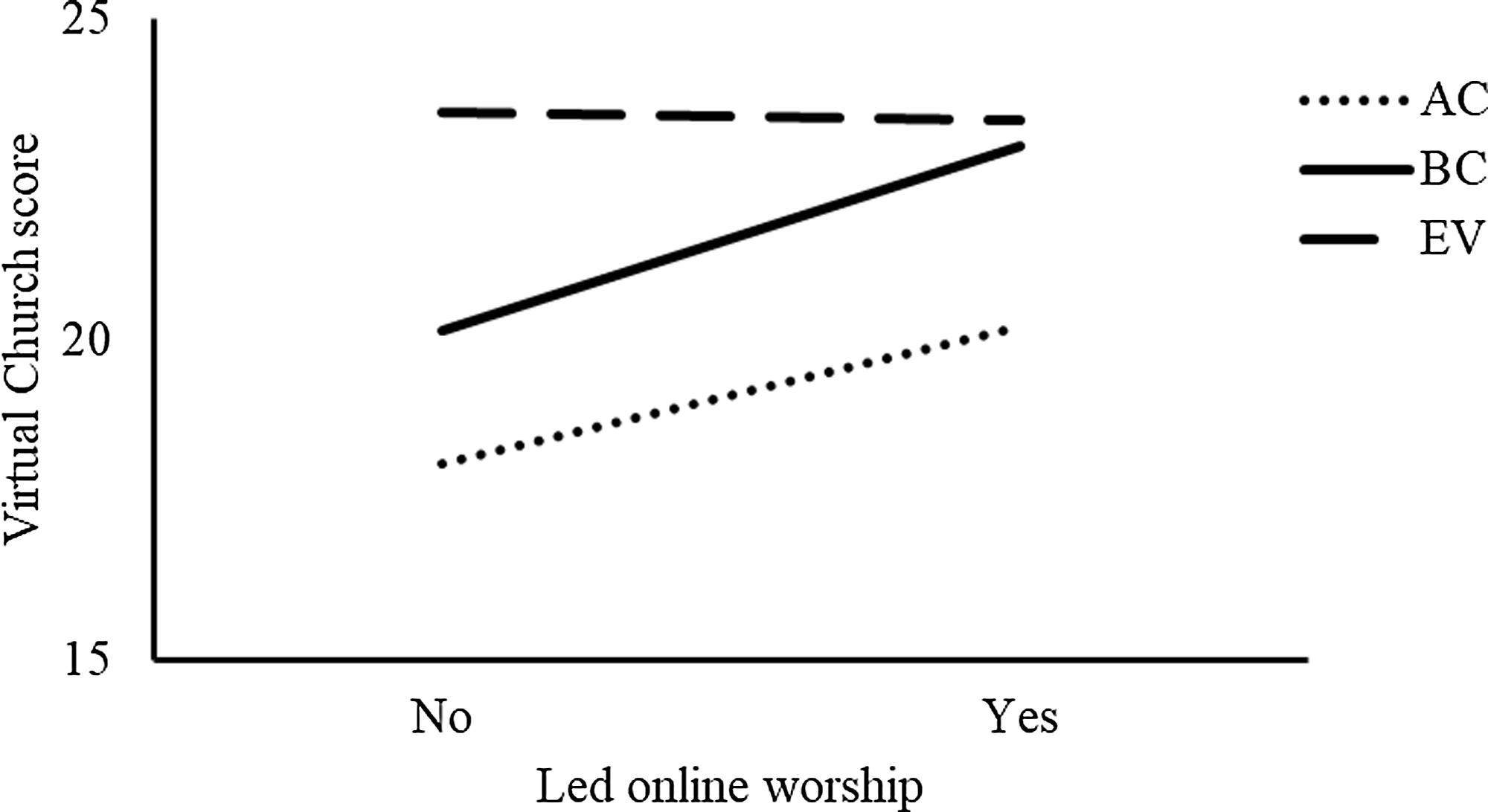
Figure 1. Interaction of church tradition and having led online worship on SoCiDOF.
Note: AC = Anglo-Catholic, BC = Broad Church, EV = Evangelical.
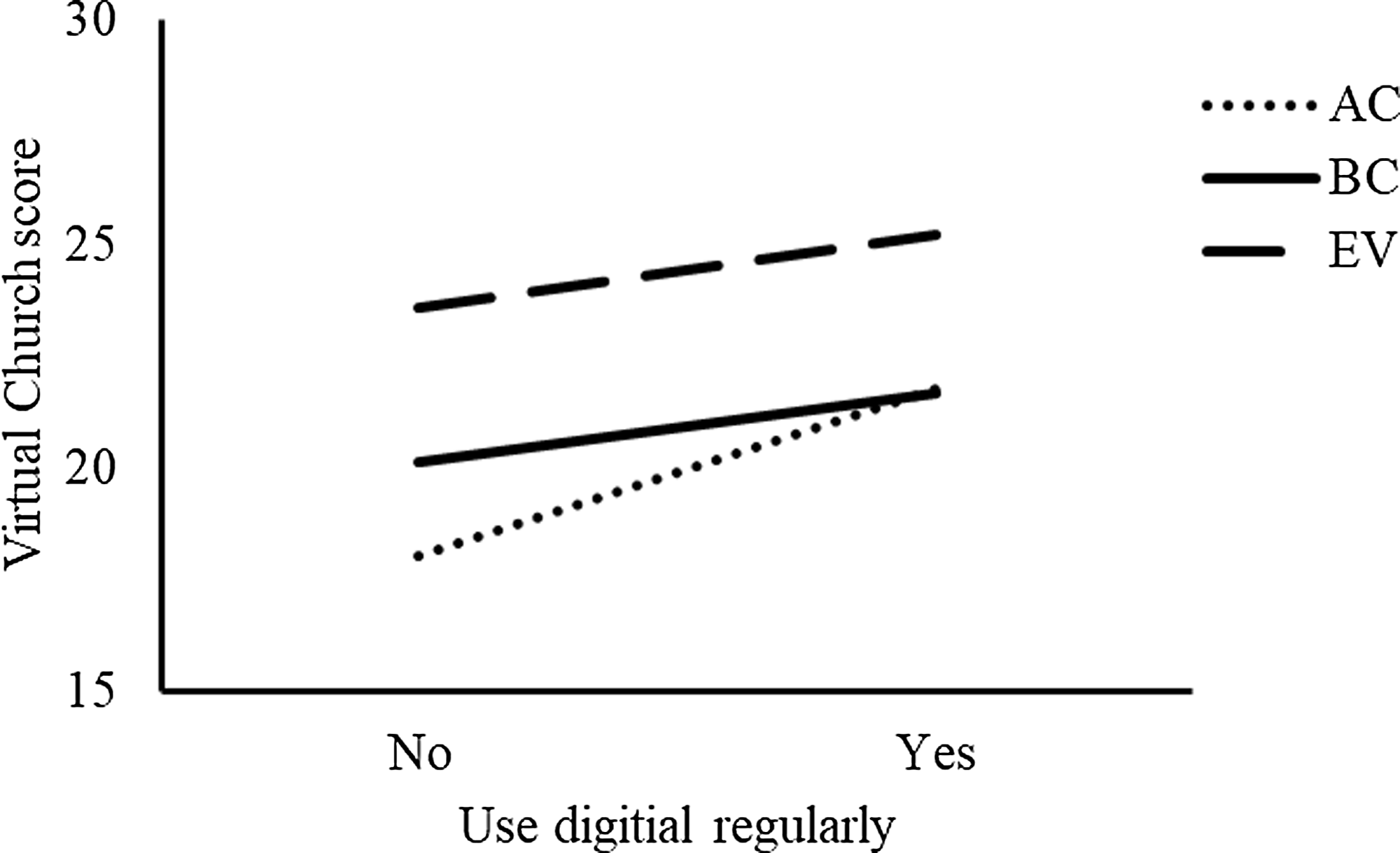
Figure 2. Interaction of church tradition and having used online meetings regularly on SoCiDOF.
Note: AC = Anglo-Catholic, BC = Broad Church, EV = Evangelical.
Predictors of Psychological Well-being
Bivariate correlations (Table 6) showed that increases in positive and negative affect during the pandemic were negatively correlated (r = −.48, p < .001) but the size of the coefficient suggested they were not simply inverse measures of one another, which is in line with balanced affect theory. Balanced affect theory is also validated by the different patterns of correlations between the predictor variables and positive affect on the one hand and between the predictor variables and negative affect on the other hand. Positive affect was positively correlated with SoCiDOF scores, extraversion, Charismaticism and conservative morality, and negatively correlated with volatility and traditional worship (Table 6). Positive affect was higher among Evangelicals compared with other traditions, and higher among those living in inner city compared with other locations. Negative affect was positively correlated with volatility and was higher among those who regularly used digital platforms in ministry, and among stipendiary parochial clergy compared to other clergy. Negative affect was negatively correlated with age and conservative morality, and lower among those from inner cities, among self-supporting and active retired ministers, and among Evangelicals. It was uncorrelated with the SoCiDOF scores.
Table 6. Bivariate correlations with positive affect and negative affect
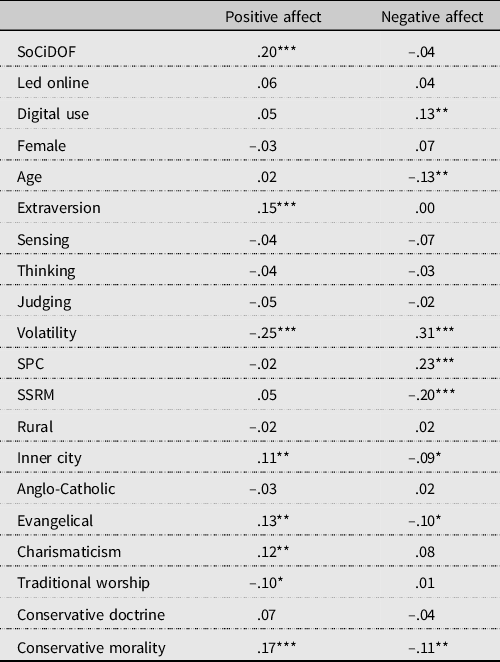
Note: For explanation, see Table 4.
Hierarchical Linear Regression
Multiple regressions examining the effect of SoCiDOF scores on changes in positive affect and on changes in negative affect showed that the bivariate trends remained after controlling for all other variables (Tables 7–8). The main predictors of increases in positive affect were higher scores for SoCiDOF, extraversion and conservative morality, and lower scores for emotional volatility. The main predictor of increases in negative affect was higher scores for emotional volatility. Increases in negative affect were negatively correlated with conservative morality, positively correlated with Charismaticism, and lower among Evangelicals than in other traditions. There was no effect of SoCiDOF scores on changes in negative affect. Digital experience (led online and digital use) had little effect on changes in either positive affect or negative affect.
Discussion and Conclusion
This paper set out to address the deceptively simple, yet broad, research question concerning the connection between changes in clergy personal psychological well-being during the pandemic and the move to digital/online technology. The research question was inspired and shaped in response to two of the specified objectives of the Living Ministry Research Project: understanding ‘the factors that enable ordained clergy to flourish’ and understanding ‘how these factors vary according to person, background, training pathway, type of ministry, context, etc.’. While the two recent reports from the Living Ministry Research Project paid attention to well-being and to engagement with digital technology during the pandemic, this study had not been designed and conceptualized in a way that could establish the connection between these two factors. Rather the skilful blend of quantitative and qualitative data provided rich illustration of how individual participants perceived the connection. Against that background, this paper revisited the second of the Church Times pandemic surveys that had been established within the individual differences tradition, and employed the individual differences approach to assess the broad research question concerning the connection between changes in clergy psychological well-being during the pandemic and the move to digital/online technology. Seven main conclusions emerge from the analyses presented in this study.
The first conclusion concerns the way in which well-being was conceptualized and operationalized. The Index of Balanced Affect Change (TIBACh) focused on personal psychological well-being through the lens of balanced affect theory. This theory conceptualizes psychological well-being not as a single continuum from negative affect to positive affect, but as two partly independent (but correlated) systems. The data from the present study confirmed the validity of this model by demonstrating how the predictors of individual differences in positive affect were different from the predictors of individual differences in negative affect. By viewing these two systems separately, it is possible for intervention strategies to target different approaches in respect of positive affect and negative affect. Previous work on the Francis Burnout Inventory (FBI) has drawn two conclusions. While it may be difficult to protect clergy from the experiences that generate negative affect, it may be wiser to focus intervention strategies on factors that promote positive affect. Increases in positive affect mitigate the debilitating consequences of negative affect. There are practical implications from employing the balanced affect model in clergy-related research. Those with responsibility for the pastoral oversight of clergy may be encouraged to help clergy identify, and thus to develop, those areas of ministry that resource their personal sense of positive affect.
The second conclusion concerns the way in which experience of digital/online technology was conceptualized in terms of an attitudinal (affective) measure (Scale of Confidence in the Digital/Online Future) alongside two behavioural measures (leading online services, digital use for ministry). The data from the present study both confirmed the greater predictive power of the attitudinal measure, and demonstrated how the variance predicted by the behavioural measures was absorbed by the affective measure. This finding holds implications both for future research among clergy and for intervention strategies. Future clergy-related research may benefit from giving greater attention to attitudinal measures. Future intervention strategies designed to enhance clergy well-being may be advised to focus on shaping attitudes alongside fostering behavioural skills. Specifically within the field of equipping clergy for confidence in the digital/online future, the task may be more complex than offering technical training.
The third conclusion concerns the way in which the simple question concerning the connection between changes in clergy psychological well-being during the pandemic and the move to digital/online technology was contextualized within five sets of control variables: personal variables (sex and age), psychological variables (extraversion, sensing, thinking, judging and volatility), contextual variables (ministry status and location), ecclesial variables (Anglo-Catholic, Evangelical and Charismaticism), and theological variables (distinguishing between stances on worship, doctrine and morality). The individual differences tradition embraces sociological, psychological and theological constructs. The correlation matrices and the regression models demonstrate that such variables help to illuminate how the factors enabling ordained clergy to flourish vary according to person, background, type of ministry, context, and so on. Translated into pastoral practice, these findings carry important implications for those with responsibility for clergy professional development. Working with an individual differences model begins by listening to and valuing the distinctive characteristics of the individual rather than with commitment to a general programmatic strategy.
The fourth conclusion concerns the way in which correlations among the control variables (see Table 4) help to illuminate how the psychological type profile of clergy influences both their ecclesial stance and their theological position. Thus, Anglo-Catholic clergy tend to be more introverted, while Evangelical clergy tend to be more extraverted and more likely to prefer thinking over feeling. Charismatic clergy tend to be more extraverted, more intuitive, more feeling and more perceiving. Preferences for traditional worship, conservative doctrine and conservative morality are higher among sensing types. Additionally, preferences for conservative doctrine and conservative morality are higher among thinking types, while preferences for traditional worship are higher among introverts and judging types. These findings are consistent with those reported in much previous work. Moreover, there are practical implications for clergy professional development that emerge from these findings. It may be a mistake to ignore the psychological differences in personality that underpin ecclesial and theological differences within the Anglican Church. Clergy professional development programmes rooted in the personal exploration of deep-seated differences in normal personality may result both in enriching individual self-awareness and in enhancing appreciation for and acceptance of wider diversity in theological preferences and expression.
The fifth conclusion concerns the predictors that shape individual differences in confidence in the digital/online future. While the correlation matrix suggests that psychological factors have a part to play (with greater confidence among extraverts, intuitive types and perceiving types), the regression model demonstrates that the influence of psychological factors is mediated through ecclesial and theological factors. Those who have least confidence in the digital future are Anglo-Catholics and clergy who hold to traditional worship and conservative doctrine. These findings are consistent with the wider picture that Anglo-Catholic clergy felt more disadvantaged by and more stressed by the Church of England’s response to the lockdown by the closure of churches and by the migration to online worship. For Anglo-Catholics this cut at the very heart of their ecclesial and theological formation. Within a Church that claims deep roots within both the Catholic tradition and the Reformed tradition, such factors may need to be taken seriously in ensuring appropriate support for all clergy across ecclesial and theological diversity.
The sixth conclusion concerns the predictors that shape individual differences in positive affect and negative affect. The main observation is that the strongest predictor in both cases is emotional volatility. Emotional volatility, sometimes termed neuroticism, is a fundamental personality difference that can be identified by routine psychological testing. As the regression models demonstrate, clergy who score high on this personality factor are susceptible to higher levels of negative affect and lower levels of positive affect. Clergy who are aware of increased vulnerability may be better equipped to manage their personal experiences. Those with responsibility for the pastoral oversight of clergy may be wise to focus on this area. Within the contexts of the assessment of vocations, initial ministerial formation and continuing ministerial development, appropriate personality assessment may be fruitful in respecting, valuing and nurturing development for personal and professional flourishing. In this context personality assessment is concerned with neither character nor pathology, but with identifying core individual predispositions.
The seventh conclusion addresses directly the deceptively simple, yet broad, research question that motivated the present study concerning the connection between changes in clergy personal psychological well-being during the pandemic and the move to digital/online technology. On the terms in which the research was conceived, employing the balanced affect model of well-being, the data demonstrated that confidence in the digital/online future predicted individual differences in positive affect, but not in negative affect. In other words, clergy who had confidence in the digital/online future enjoyed more positive affect, but this confidence did nothing to reduce the negative affect that they experienced. The theoretical basis of the balanced affect model suggests, however, that this enhanced positive affect reduces the deleterious consequences of negative affect. In this sense, clergy who have confidence in the digital/online future enjoy an overall better sense of personal well-being. The finding that attitudinal predisposition (confidence in the online future) was of greater importance than behavioural engagement with the online world suggests that clergy professional development programmes may be wise to target affective development, rather than or alongside cognitive development (knowledge and belief based) or behavioural development (practice and skill based).
Limitations of this Study
This study assessed the impact of confidence in the digital/online future during the pandemic on changes in psychological well-being among Anglican clergy, and it did so by self-reported measures of perceived change in positive affect and perceived change in negative affect, relying on cross-sectional rather than longitudinal measures of psychological well-being. This design is not as robust as would have been the case were we to have been able to measure psychological well-being among the same participants before and after the onset of the pandemic. Nonetheless, self-report measures of perceived change in positive affect and perceived change in negative affect are useful for modelling effects on cross-sectional data and provide the only viable option within the current pandemic. Future studies in times of crisis in the Church of England would be helped by having ongoing long-term panel studies conducted among clergy that include appropriate and robust measures.
Disclosure Statement
No potential conflict of interest was reported by the author(s).
Ethical Approval
Ethical approval was granted by the Research Ethics Committee for the School of Humanities, Religion and Philosophy at York St John University (approval code: HRP-RS-AV-0420-01). All participants had to affirm they were 18 or over and give their informed consent by ticking a box that gave access to the rest of the survey.














